 Søværnet
Søværnet
The origins of the Danish Navy
Medieval Period (10th-15th Centuries): The Viking Era is a sure way to identify the very origins of the “Danish Navy” traced back to the first Scandinavian expansion in the 8th-11th centuries, with Danish Vikings noted as renowned seafarers and warriors on their “langskips” (see the page) and their daring raids but also exploration and trade endeavours. The Viking kingdoms were once united under a single banner (then several again) but Christianized by the 12th century, leading to organize standing naval forces to protect its interests and trade routes in the Baltic Sea and beyond.
Then followed the Union and Expansion in 15th-16th Centuries, starting with the Kalmar Union (1397-1523) in which Denmark, Norway, and Sweden were united under a single monarch. The Danish fleet played a significant role in maintaining control over the union’s territories. It saw more significant development under King Hans (r. 1481-1513) and his successor, King Christian II (r. 1513-1523), with the establishment of a more structured naval administration and the construction of larger warships.
The Renaissance and Early Modern Period in the 16th-17th Centuries saw Denmark engaged in the Northern Seven Years’ War (1563-1570), actively involved against Sweden, demonstrating its growing capabilities. Lessons were learned and intensive naval Reforms ordered Under King Christian IV (r. 1588-1648), including the construction of new shipyards and modernization of the fleet. The naval base at Holmen in Copenhagen was established.
In 17th-18th Centuries saw the Scanian War (1675-1679) in which the Danish Navy played a crucial role against Sweden again, achieving significant victories that enhanced Denmark’s naval prestige. The Great Northern War (1700-1721) saw a participation which further highlighted the strategic importance of its navy, although the war also strained its resources.
The 18th Century saw the Danish Navy maintaining a strong presence in the Baltic Sea, with a fleet that included quite large ships of the line.
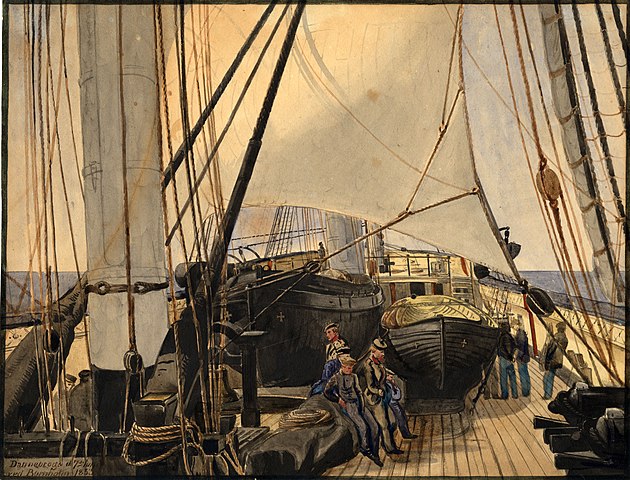
The Napoleonic Wars (1803-1815) saw the navy suffering a significant setback during the Battle of Copenhagen in 1801, when the British fleet under Admiral Nelson attacked and captured much of the Danish fleet. In 1807, Copenhagen was bombarded again, leading to further losses.
The were considerable rebuilding efforts after the Napoleonic Wars, and Denmark focused on rebuilding its navy, taking soon into consideration steam power from the mid-19th century, marking a significant technological shift.
The Danish Navy in 1850
Close to the Crimean war, Scandinavian power and prestige has fell below the Netherlands and mostly giants such as France and Britain.
The Danish Navy in 1860
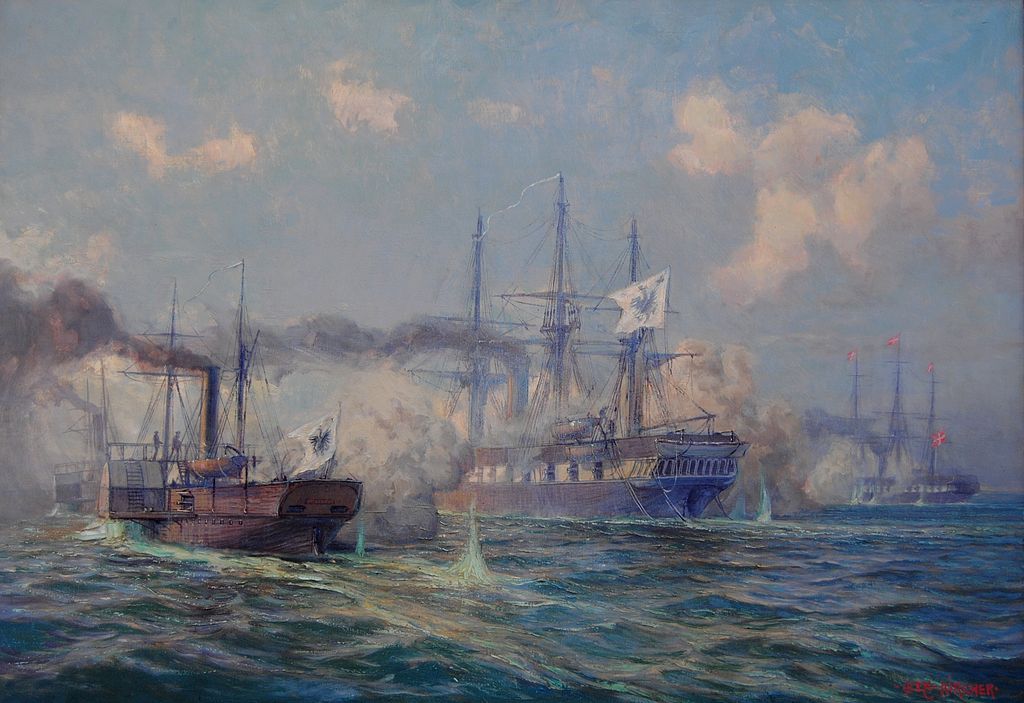
The Battle of Jasmund
The Battle of Jasmund, also known as the Battle of Rügen, took place on March 17, 1864, during the Second Schleswig War. This conflict was fought between the Kingdom of Denmark and the combined forces of Prussia and Austria over control of the duchies of Schleswig and Holstein. The Second Schleswig War began in February 1864 after the Danish government attempted to integrate the duchy of Schleswig more closely with the Danish kingdom, violating the London Protocol of 1852. This move was opposed by the German Confederation, particularly Prussia and Austria, leading to the outbreak of hostilities.
The Battle of Jasmund occurred off the coast of the Jasmund Peninsula on the island of Rügen in the Baltic Sea. The engagement involved the Danish navy and a Prussian naval squadron. The Danish fleet, commanded by Rear Admiral Edouard Suenson, sought to blockade Prussian ports and disrupt their maritime activities. The Prussian fleet, under the command of Eduard von Jachmann, aimed to challenge Danish naval dominance and ensure the supply and communication lines for their forces.
Danish Fleet: The Danish naval forces included the ironclad frigate Rolf Krake and several wooden steam frigates and corvettes. The Rolf Krake was notable for being one of the first ironclad warships in the world.
Prussian Fleet: The Prussian squadron consisted of wooden warships, including steam frigates and gunboats. The Prussians lacked ironclad vessels, putting them at a disadvantage in direct combat with the Danish fleet.
The battle began when the Danish fleet encountered the Prussian squadron near the Jasmund Peninsula. The superior firepower and armor of the Danish ironclad Rolf Krake played a crucial role in the engagement. Despite being outnumbered, the Danish fleet managed to inflict significant damage on the Prussian ships.
The Rolf Krake engaged the Prussian flagship SMS Arminius, causing heavy damage. The Prussians attempted to use their numerical advantage to encircle the Danish ships, but the maneuverability and firepower of the Rolf Krake and the support from other Danish vessels thwarted these efforts.
The Battle of Jasmund ended inconclusively, with both sides claiming victory. The Danish fleet successfully prevented the Prussian squadron from breaking the blockade, thereby maintaining Danish naval dominance in the Baltic Sea. However, the Prussian fleet managed to withdraw without losing any ships, maintaining their operational capability.
The Battle of Jasmund demonstrated the tactical advantages of ironclad warships over traditional wooden vessels, highlighting the importance of naval technology in 19th-century maritime warfare. The engagement also underscored the strategic importance of controlling sea lanes and blockading enemy ports during wartime.
While the battle did not decisively alter the course of the Second Schleswig War, it was an important demonstration of naval power and a precursor to future naval engagements where ironclad ships would play a dominant role. The war eventually concluded with the Treaty of Vienna in October 1864, resulting in the Danish cession of Schleswig, Holstein, and Lauenburg to Prussia and Austria.
The Danish Navy in 1860 consisted mainly of sailing ships, the principal screw vessels being one 64-gun battleship, two frigates and two corvettes. It was clear however that sooner or later war would occur with the German Confederation over Schleswig-Holstein, which amounted to a third of the total area of Denmark though Holstein was predominantly German. Thus by the end of 1863 the Danes had converted their best sail battleship, the Dannebrog, to a broadside ironclad, their best frigate, the Tordenskjold, to screw, acquired the small turret ship Rolf Krake and two lightly armoured gunboats as well as completing a screw wooden cruiser (frigate), a screw sloop and two 550t gunboats.
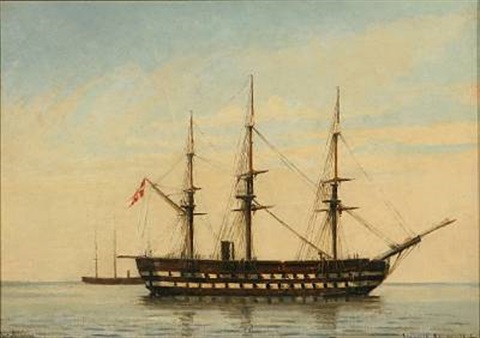
Major Combat ships:
-SKJOLD (1833) converted steam 1858-1860: 2550t 64-30pdr 8kts
-NIELS JUEL (1855): 2320t 42-30pdr 10kts
-SJAELLAND (1858): 2320t 42-30pdr 10kts
-THOR (1851): 1000t 12-30pdr 9kts
-HEIMDAL (1856): 1170t 16-30pdr 9kts
The fleet counted also six side-wheel steamers with 2 to 12 guns each. The principal sailing ships were: Waldemar and Frederik 30-30pdr, and 54-18pdr in each, Dannebrog, 72-30pdr, the Rota, Havfruen and Bellona, 46-18pdr in each; Tordenskjold, 44 Galathea, 26-18pdr; Valkyrien, 20-18pdr; Najaden, 14-30pdr; Saga, 12-18pdr. Dannebrog and Tordenskjold were later converted to screw.
In 1864 when Austria and Prussia invaded, the Danes, though hopelessly outnumbered on land, were able with some difficulty to blockade the Prussian coast. The Elbe and Weser blockades were broken after an action off Heligoland on 9 May in which the Niels Fuel, Fylland and Heimdal had the better of the fighting against 2 Austrian frigates and 3 small Prussian gunboats. The Rolf Krake was driven off by the Prussian batteries when she attempted to prevent the crossing of the channel between Schleswig and Alsen on 29 June, and the war ended on August, with the cession of Schleswig-Holstein.
The sticking point was the Second Schleswig War (1864) in which the Danish Navy participated in this conflict against Prussia and Austria, but the war ended in a Danish defeat.
In the period from 1864 to 1872 the Danes built or acquired 2 more broadside ironclads, 2 small turret ships and a low freeboard central battery ship, as well as a small wooden-hulled cruiser, while 5 gunboats) were launched in 1873-1875. Subsequently in the ten years from 1878 ‘ to 1888, 2 coast defence battleships, a torpedo ram, 2 cruisers of which one was intended for the Danish West Indies, 2 gunboats and 17 ; torpedo boats were launched, but construction then slackened and – from 1889 to 1895 the only ships launched were 3 small cruisers and 5 – torpedo boats. The next 10 years saw the launching of 3 low freeboard coast defence battleships and 3 torpedo boats.
The Danish Navy in 1870
The Danish Navy in 1880
After the loss of Schleswig-Holstein, the area of Denmark was only 14,830 square miles with a population in 1905 of about 2,500,000, and any attempt to maintain a large navy was clearly impossible. Greenland, Iceland and the Faeroe islands, the latter an integral part of the Kingdom, belonged to Denmark but their occupation by a major power would not have been tolerated by Britain. The three Danish West Indian islands of St Thomas, St John and St Croix were relatively unimportant except for the fine harbour in St Thomas, so that the Danish fleet was essentially a coast defence one.
The majority of Danish ships were built at Copenhagen dockyard. The torpedo boats were mainly Thornycroft though the last 6 were built at Copenhagen. Heavy guns were at first Armstrong RML, but then Krupp BL, followed by Canet and then Bofors.
Danish Ships 1860-1880
 SKJOLD (1833)
SKJOLD (1833)
 Skjold was a 94 guns 2-decker, 2nd rate. Built at Orlogsværftet, Nyholm designed A. Schifter. Launched 1833, completed 1836 (to be exact launched on 09/12/1833, commissioned 05/03/1836). From 1860: She was converted to steam and became a screw-propelled Ship-of-the-Line. She was discarded on 11/22/1873.
Skjold was a 94 guns 2-decker, 2nd rate. Built at Orlogsværftet, Nyholm designed A. Schifter. Launched 1833, completed 1836 (to be exact launched on 09/12/1833, commissioned 05/03/1836). From 1860: She was converted to steam and became a screw-propelled Ship-of-the-Line. She was discarded on 11/22/1873.
Specs: Diplacement: 1344t, Dimensions: 56.74 x 14.44 x 6.59m (180 ft 10 in x 46 ft x 19 ft 9 in, mean draught 21 ft)
In 1860 after steam conversion she jumped to 57.96 meters overall x 14.44 meters beam x 7.43 m meters in draft
Propulsion in 1860: One steam engine from Baumgarten & Burmeister, rated for 300HP, 9.7 kts. Unlimited range, 3 masted rigged.
Armament in 1833: 84 guns: 30x 30-pdr,54x 18-pdr, 10x 4-pdr Howitzers on deck, swivel mounts.
Armament in 1860: 64guns: 58x 30-pdr, 6x 18-pdr RML
Crew: 770
Apart Skjold, which was rebuilt, the Navy also had the following ships of the line:
Waldemar 94 guns (1830): Discarded 1864
Frederik VI 94 guns (1832): Discarded 1872
Christian VIII (1841): 84 guns. Destroyed by coastal artillery at Eckernförde in 1849
The most interesteding was Dannebrog, a 82 guns (1853) 2 deckers as she was rebuilt in 1863 as 16-gun armored frigate (see below)
 NIELS JUEL class (1855)
NIELS JUEL class (1855)
HDMS Niels Juel, Sjaelland
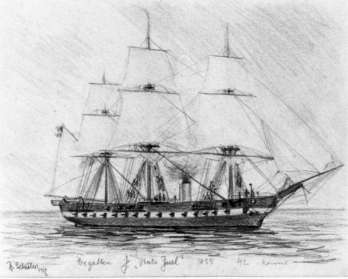
src navalhistory.dk
Both steam, composite frigates were made at the Naval Dock Yard, Copenhagen, the lead ship laid down on May 25, 1853, Launched on September 20, 1855 and Commissioned in 1856. Niels Juel was decmmissioned on August 25, 1879.
Specs: 1,934 tons full load, dimensions 58.0 x 13 x 6.0 m
One Horizontal Maudslay, Sons & Field steam engine rated for 300 Hps woth four squared boilerts, 9.8 knots up to 10 kts. Range unlimited thanks to barque rigging.
Originally they carried thirty 30-pounds/50 Guns and twelve 30-poundser/40 rifled Guns
In 1864 they were redoved with thorty new 30-poundser/50 MR rifled in the battery, eight 18-pounder RML and four 12-pounder RML on deck.
Later in 1970 they had two 8 inches Guns and 24 six inches plus one swivel 3 inches.
 THOR (1851)
THOR (1851)
Little info, in research. 1,000t 12-30pdr 9kts
 HEIMDAL (1856)
HEIMDAL (1856)
Little info, in research. 1,170t 16-30pdr 9kts
 Dannebrog (1863)
Dannebrog (1863)
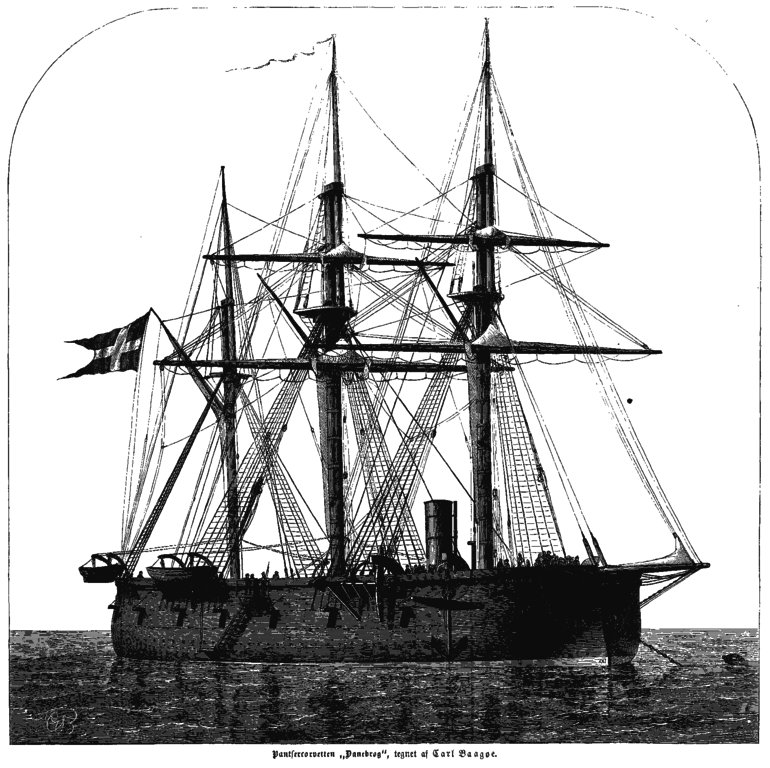
For this dive into two decades of Danish warships, we start with one of the most symbolic of its evolution and transformation to steam and armour:
The Danish ironclad Dannebrog was an armored frigate originally built as a classic 80-gun ship-of-the-line, planned in 1845, built by Andreas Schifter in 1848. She was launched in 1850but construction was suspended until she was redesigned and completed as a steam-powered ironclad, in the early 1860s. She had an uneventful career however, before being stricken in 1875. She became an accommodation ship until converted again as a target ship in 1896 and being sold and BU in 1897.
 PEDER SKRAM (1864)
PEDER SKRAM (1864)
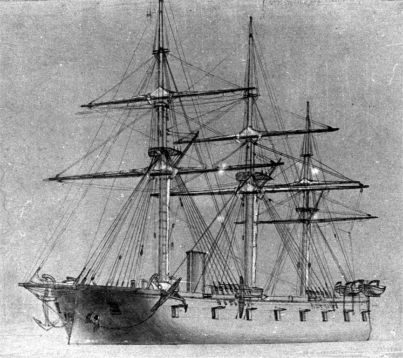
PEDER SKRAM was built in Copenhagen in 1864, laid down as a regular screw frigate, but it was decided in 1862 she should be armored, and thereby as converted she became the first Danish built armored ship, essentially a wooden-hulled frigate class broadside ironclad.
Displacement: 3330t
Dimensions: 228ft pp x 49ft 9in x 20ft 7in max (67.26 x 15.16 x 6.27m)
Powerplant: 1 HS engine 1680 ihp: 11.5kts
Armour: Iron 4-in (102 mm)
Armament: 6-8in RML, 12-rifled 26pdr/49cwt
Complement: 435
 DANMARK (1864)
DANMARK (1864)

DANMARK was built in Britain at Thompson, launched 1864 as an iron-hulled broadside corvette, with the hull completely armoured above the waterline. Originally intended for the Confederate States and built undercover with the names of “Santa Maria” or “Glasgow”. The 44 inches armour was composite, with wrought iron backed by teak.
Displacement: 4670t
Dimensions: 270ft pp x 50ft x 19ft 6in max (82.29 x 15.24 x 5.94m)
1 reciprocating steam engine 1000 hip, 8.5kts. Coal 625t
Armour: Iron, 44-inches (1,17 meters)
Armament: 12-8in RML, 12-rifled 26pdr/49cwt
Complement: 530
 ROLF KRAKE (1864)
ROLF KRAKE (1864)
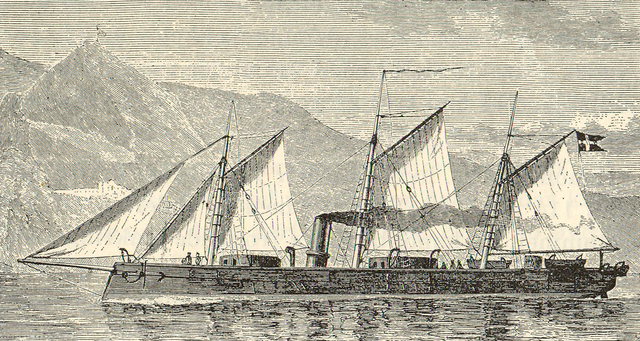
ROLF KRAKE was built at Napier in 1863 as a twin-turret ship (Coles Type) with lowering bulwarks and schooner-rigged. The first ship ever in the world with Coles turrets. The 4-68pdr SB were later replaced by 8-inches RML and two 3.4in/24 as well 4-1pdr revolvers were added.
Displacement: 1380t
Dimensions: in pp x 38ft 2in x 10 ft 6in (96.00 x 11.63 x 3.20m)
1 shaft recip. steam engine, 2 boilers, 750 ihp, 9.5kts, Coal 135t
Armour: Iron, Side 44-in (composite), turret 44-in
Armament: 4-68pdr SB (2×2 in turrets)
Complement: 150
 LINDORMEN (1868)
LINDORMEN (1868)
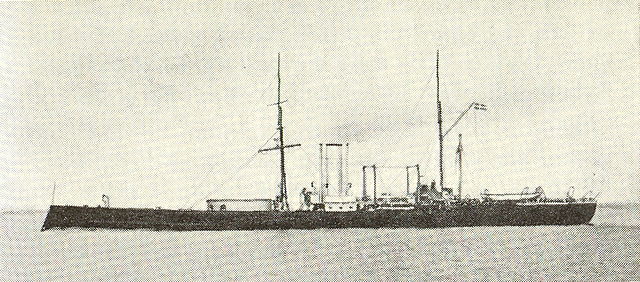
LINDORMEN was built at Copenhagen, launched 1868 as a low freeboard single-turret ship, coles type. She had four 3in/24 and 4-lpdr revolvers were later added, and the 9in RMLs replaced by 2-5.9in.
Displacement: 2048t
Dimensions: 217ft 11-in x 39ft 4-in x 14ft 7in max (66.42 x 11.99 x 4.44m)
1 shaft recip. steam egnine 2 boilers 1500 hp, 12kts. Coal 125t
Max Armour wrought Iron, side 5-in, turret 5-in
Armament: 2-9in RML originally, in a single Coles turret
Complement: 150
 GORM (1870)
GORM (1870)
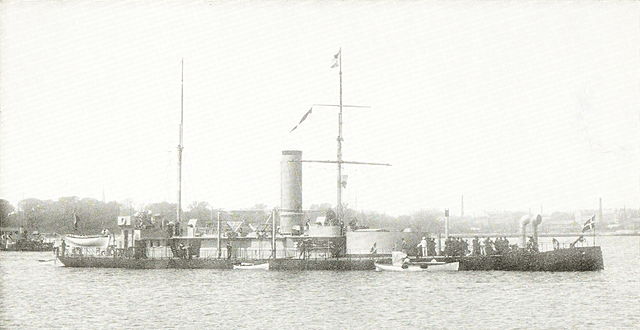
GORM was built at Copenhagen, launched 1870 as a low freeboard single-turret ship. The armament was altered, 4-3.4in/ 24 and 4-Ipdr revolvers being added, the 3.4-in then being replaced by 6-pdrs, an finally the two 10-in RML by 2-5.9-in/43
Displacement: 2313t
Dimensions: 233ft 4in pp x 40ft x 14ft 4in max (71.11 x 12.19 x 4.37m)
1 shaft recip. steam egnine 2 boilers, 1600 ihp, 12.5kts. Coal 113t
Armour: Wrought iron, belt 7-in, turret 8-in.
Armament: 2x 10-in RML
Complement: 160.
 ODIN (1872)
ODIN (1872)
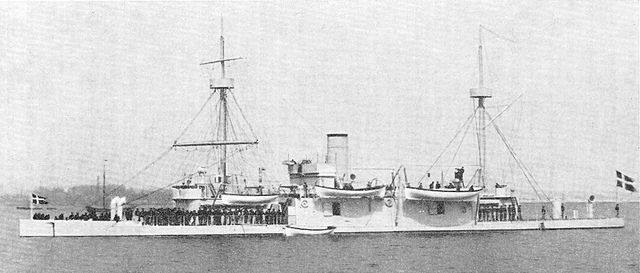
HDMS ODIN was built at Copenhagen, launched 1872. She was another low freeboard central battery ship, armoured above water, completely. with the unusual feature of a withdrawable spur ram, The 10in RMN guns were Converted to 16 calibre BLs by Krupp, and the final armament also included 43.4in/ 24, 4-lpdr revolvers and 2-1pdr pompoms. She was scrapped in 1912.
Displacement: 3170t
Dimensions: 24 ft 10in pp x 48ft 6in x 16ft Sin max (73.40 x 14.78×5.00m)
1 shaft recip. steam egnine 2 boilers, 2300 ihp, 12kts. Coal 177t
Armour: Wrought Iron, side and battery 8-in
Armament: 4-10in RML
Complement: 206
 Stærkodder (1864)
Stærkodder (1864)
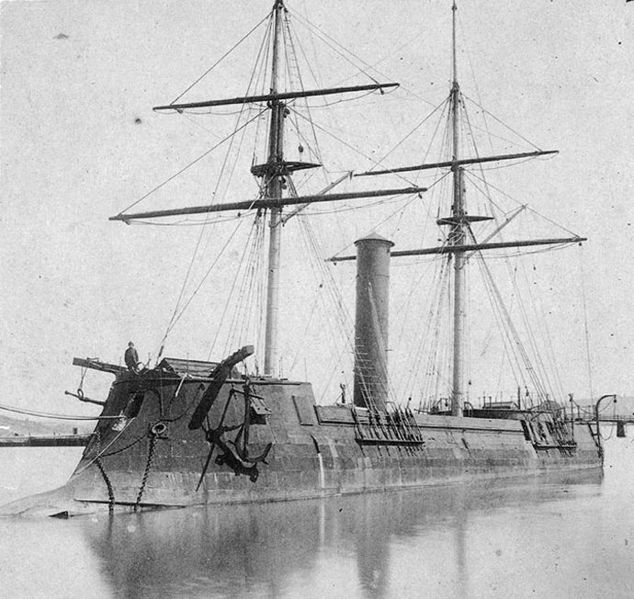
The former confederate turret ram vessel ordered under cover as Sphinx at Arman Bros/ Bordeaux, was sold to Denmark under the name Stærkodder on 31 March 1864.
Manned by a Danish crew, she left Bordeaux for her shakedown cruise on 21 June 1864. The crew tested the vessel while negotiations took place between Danish Naval Ministry and Arman over the final price and disagreement over compensation for cited problems and late delivery. They broke down on 30 October, but she still sailed for Copenhagen, Denmark, on 25 October. The Danish government refused to relinquish the vessel and she arrived on 10 November and to Orlogsværftet dockyard in early 1865. So at the beginning of 1865 the Danes sold the ship to the Confederacy, see the career of Kotestu for more.
 HDMS Helgoland (1878)
HDMS Helgoland (1878)
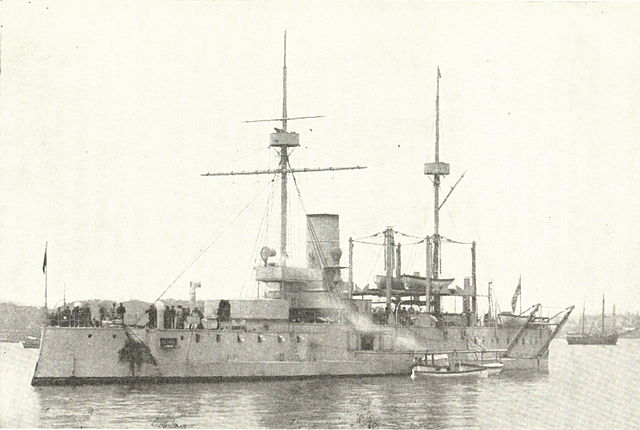
HDMS Helgoland was a coast defence barbette ironclad bult for the Royal Danish Navy in the late 1870s. The ship was decommissioned in 1907 and subsequently scrapped.
Barbette ironclad
Displacement: 5,480 t (5,393 long tons)
Dimensions 79.17 x 18.05 x 5.9 m (259 ft 9 in x 59 ft 3 in x 19 ft 4 in)
2 shafts compound-expansion steam engines, 8 cyl. boilers 4,000 ihp (3,000 kW), Speed: 13 knots, Range 1,400 nmi/9 knots
Armour: Belt: 152–315 mm (6.0–12.4 in), Barbette: 260 mm (10.2 in), Casemate: 260 mm (10.2 in), Deck: 52 mm (2 in)
Armament 1× 305 mm (12 in) gun, 4× 260 mm (10.2 in), 5× 120 mm (4.7 in)
Complement: 350
Read More/Src
Books
Balsved, Johnny E. “Armored Frigate PEDER SKRAM (1866–1885)”. Danish Naval History.
Gardiner, Robert, ed. (1979). Conway’s All the World’s Fighting Ships 1860–1905. Conway Maritime Press.
Silverstone, Paul H. (1984). Directory of the World’s Capital Ships. New York: Hippocrene Books.
Naval and Military Notes: “Denmark”. Journal of the Royal United Service Institution. XXXIX (214). London: J. J. Keliher & Co.
Links
navalhistory.dk/
milhist.dk/1922/
navalhistory.dk/ PederSkram
oceania.pbworks.com/w/
navalhistory.dk RolfKrake%281863%29.htm
http://www.milhist.dk /rolf_krake_uk.htm
navalhistory.dk Danmark%281864%29.htm
milhist.dk/ dannebrogs-endeligt/
navalhistory.dk/ Odin 1874
/en.wikipedia.org/ Battle_of_Jasmund
navypedia.org/ denmark/dk_bb.htm


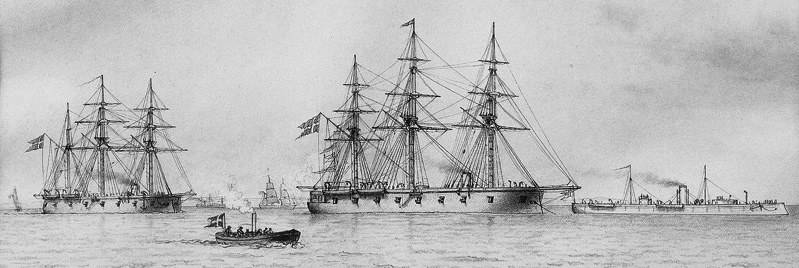
 Latest Facebook Entry -
Latest Facebook Entry -  X(Tweeter) Naval Encyclopedia's deck archive
X(Tweeter) Naval Encyclopedia's deck archive Instagram (@navalencyc)
Instagram (@navalencyc)





 French Navy
French Navy Royal Navy
Royal Navy Russian Navy
Russian Navy Armada Espanola
Armada Espanola Austrian Navy
Austrian Navy K.u.K. Kriegsmarine
K.u.K. Kriegsmarine Dansk Marine
Dansk Marine Nautiko Hellenon
Nautiko Hellenon Koninklije Marine 1870
Koninklije Marine 1870 Marinha do Brasil
Marinha do Brasil Osmanlı Donanması
Osmanlı Donanması Marina Do Peru
Marina Do Peru Marinha do Portugal
Marinha do Portugal Regia Marina 1870
Regia Marina 1870 Nihhon Kaigun 1870
Nihhon Kaigun 1870 Preußische Marine 1870
Preußische Marine 1870 Russkiy Flot 1870
Russkiy Flot 1870 Svenska marinen
Svenska marinen Søværnet
Søværnet Union Navy
Union Navy Confederate Navy
Confederate Navy Armada de Argentina
Armada de Argentina Imperial Chinese Navy
Imperial Chinese Navy Marinha do Portugal
Marinha do Portugal Mexico
Mexico Kaiserliche Marine
Kaiserliche Marine 1898 US Navy
1898 US Navy Sovietskiy Flot
Sovietskiy Flot Royal Canadian Navy
Royal Canadian Navy Royal Australian Navy
Royal Australian Navy RNZN Fleet
RNZN Fleet Chinese Navy 1937
Chinese Navy 1937 Kriegsmarine
Kriegsmarine Chilean Navy
Chilean Navy Danish Navy
Danish Navy Finnish Navy
Finnish Navy Hellenic Navy
Hellenic Navy Polish Navy
Polish Navy Romanian Navy
Romanian Navy Turkish Navy
Turkish Navy Royal Yugoslav Navy
Royal Yugoslav Navy Royal Thai Navy
Royal Thai Navy Minor Navies
Minor Navies Albania
Albania Austria
Austria Belgium
Belgium Columbia
Columbia Costa Rica
Costa Rica Cuba
Cuba Czechoslovakia
Czechoslovakia Dominican Republic
Dominican Republic Haiti
Haiti Hungary
Hungary Honduras
Honduras Estonia
Estonia Iceland
Iceland Eire
Eire Equador
Equador Iran
Iran Iraq
Iraq Latvia
Latvia Liberia
Liberia Lithuania
Lithuania Mandchukuo
Mandchukuo Morocco
Morocco Nicaragua
Nicaragua Persia
Persia San Salvador
San Salvador Sarawak
Sarawak Uruguay
Uruguay Venezuela
Venezuela Zanzibar
Zanzibar Warsaw Pact Navies
Warsaw Pact Navies Bulgaria
Bulgaria Hungary
Hungary

 Bundesmarine
Bundesmarine Dutch Navy
Dutch Navy Hellenic Navy
Hellenic Navy Marina Militare
Marina Militare Yugoslav Navy
Yugoslav Navy Chinese Navy
Chinese Navy Indian Navy
Indian Navy Indonesian Navy
Indonesian Navy JMSDF
JMSDF North Korean Navy
North Korean Navy Pakistani Navy
Pakistani Navy Philippines Navy
Philippines Navy ROKN
ROKN Rep. of Singapore Navy
Rep. of Singapore Navy Taiwanese Navy
Taiwanese Navy IDF Navy
IDF Navy Saudi Navy
Saudi Navy Royal New Zealand Navy
Royal New Zealand Navy Egyptian Navy
Egyptian Navy South African Navy
South African Navy






























 Ukrainian Navy
Ukrainian Navy dbodesign
dbodesign